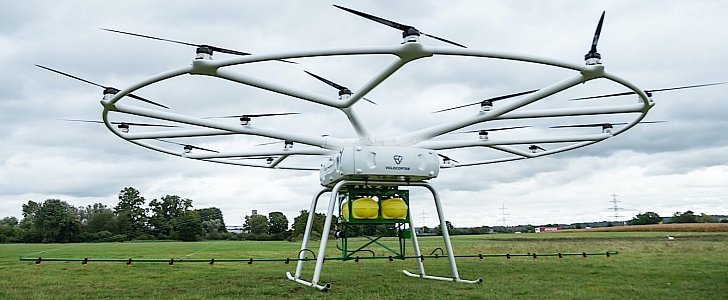Ever since drones have become part of our lives, individuals have found all sorts of uses for the technology, most of them not entirely benign or constructive. Companies, on the other hand, are definitely taking their sweet time in coming up with lucrative tasks for drones.
Take agriculture, for instance. It’s like drones have been created purposefully for use in this field, yet for some reason dedicated applications are quite limited today.
At the beginning of the month, at the Agritechnica trade fair for agricultural machinery in Hanover, Germany, John Deere and Volocopter decided it’s time to change that and they showed the “first large drone adapted for agricultural use.”
The machine is in fact a John Deere crop protection sprayer attached to 18 Volocopter rotors and all the other required hardware.
Powered by exchangeable batteries, the drone has a flight time of up to half an hour, and it can carry a variety of loads, weighing as much as 200 kg (441 lbs).
The 9.2 meters-diameter drone (30 feet) can either be remotely controlled, or set to fly a preprogrammed route carrying things like tanks, a pump, and a spray bar to the target location.
According to Volocopter, the drone can cover up to 6 hectares in low-altitude flight, making the flyer “a sustainable, precise, and cost-effective alternative to helicopters.”
The two companies have not yet announced plans to mass-produce the drone, as they didn’t even perform proper flight tests yet. But knowing John Deere, that should’t take long.
Volocopter on the other hand is a Germany-based company that just recently flew one of its air taxis over the Mercedes-Benz headquarters. It’s main area of business is creating air urban mobility solutions.
Their main product, VoloCIty, is powered by nine battery packs and 18 brushless DC electric motors and is good for 35 km (22 miles) at a top speed of 110 kph (68 mph).
At the beginning of the month, at the Agritechnica trade fair for agricultural machinery in Hanover, Germany, John Deere and Volocopter decided it’s time to change that and they showed the “first large drone adapted for agricultural use.”
The machine is in fact a John Deere crop protection sprayer attached to 18 Volocopter rotors and all the other required hardware.
Powered by exchangeable batteries, the drone has a flight time of up to half an hour, and it can carry a variety of loads, weighing as much as 200 kg (441 lbs).
The 9.2 meters-diameter drone (30 feet) can either be remotely controlled, or set to fly a preprogrammed route carrying things like tanks, a pump, and a spray bar to the target location.
According to Volocopter, the drone can cover up to 6 hectares in low-altitude flight, making the flyer “a sustainable, precise, and cost-effective alternative to helicopters.”
The two companies have not yet announced plans to mass-produce the drone, as they didn’t even perform proper flight tests yet. But knowing John Deere, that should’t take long.
Volocopter on the other hand is a Germany-based company that just recently flew one of its air taxis over the Mercedes-Benz headquarters. It’s main area of business is creating air urban mobility solutions.
Their main product, VoloCIty, is powered by nine battery packs and 18 brushless DC electric motors and is good for 35 km (22 miles) at a top speed of 110 kph (68 mph).





